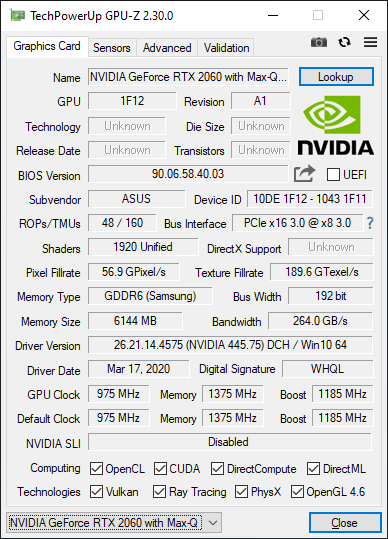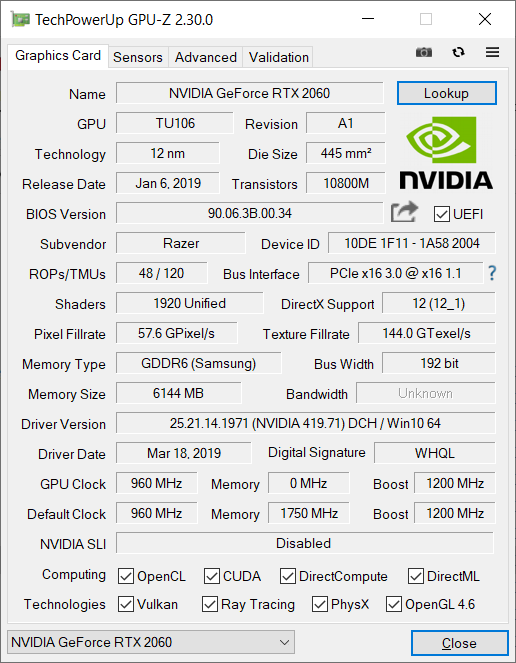AMD’s Mobile Revival: Redefining the Notebook Business with the Ryzen 9 4900HS (A Review)
by Dr. Ian Cutress on April 9, 2020 9:00 AM ESTGPU Benchmarks
Graphics is going to be a bit more challenging than the CPU tests. Games that test both the CPU and the GPU to the limits are going to find different tradeoffs with each of these systems.
The ASUS Zephyrus G14 is smaller and more thermally limited. It doesn’t have an AMD GPU, so it can’t take advantage of AMD’s new features like SmartShift that can manage power between the CPU and GPU. It technically has the stronger CPU, and while the graphics card is the same, ASUS has the Max-Q version of the RTX 2060, which is optimized for power and efficiency, and exhibits lower clocks. Technically the base frequency of this configuration is higher, at 975 MHz, the turbo is lower at 1185 MHz, and the GDDR6 memory is a lot lower at 1375 MHz (11Gbps/pin).
The Razer Blade 15 has the bigger chassis, and we assume is built for a larger overall TDP. While it has the ‘weaker’ CPU of the two, with fewer cores and lower frequency, it is paired with a full-fat GTX 2060 graphics card. We looked at the data for this card, and it exhibits a lower 960 MHz base frequency, it has the higher 1200 MHz turbo, 1750 MHz memory, and has a direct PCIe 3.0 x16 connection with the processor, while the ASUS system is only an x8.
For our tests, I’ve taken an older test (CS:Source), a couple of modern tests (Civ 6, FFXV) and a new test in Borderlands 3. We used the following settings:
- Final Fantasy, 1080p Fullscreen, Standard Quality
- Borderlands 3, 1080p, Medium Pre-Set
- Civilization 6, 1080p Maximum Preset No MSAA / 1K Occlusion Textures
- Civilization 6, 1080p Maximum Preset 8x MSAA / 2K Occlusion Textures
- Counter Strike Source, 1080p Maximum

In Final Fantasy, the results were around 10% different, favoring the AMD system.

Borderlands 3 was actually fairly close, with less than 5% between them, but still favoring AMD. I did notice that we were fairly close to the cutoff here between being CPU limited and GPU limited.

Civilization 6 is well known for constantly updating and being optimized, and here it seems the more powerful GPU wins out by a large 10 FPS margin.

However, if we add in some more compute and detail, we move to a more GPU limited scenario where the results are essentially equal.

Counter Strike is an odd one, given how old the game is. Here the game favors the Intel machine, with a ~10% advantage.
Like in the CPU tests, I did some of these gaming tests with the power cord removed and on battery saver mode. Results were interesting, to say the least, and can be found on the next page.












267 Comments
View All Comments
twtech - Friday, April 10, 2020 - link
That picture really illustrates just how gigantic the 64 core TR/Epyc really is.Keyboard1701 - Friday, April 10, 2020 - link
Going by the performance of the laptops on battery, I'm curious to see if something like a gtx 1650 might actually perform better than a rtx 2060 on battery.Keyboard1701 - Friday, April 10, 2020 - link
I apologise for the double post, but I've also observed that the iGPU actually performs just as well as the rtx 2060 when the laptop is running on battery. Would this mean that the discrete gpu is redundant for someone who mainly intends to use the laptop on battery power?RollingCamel - Friday, April 10, 2020 - link
Did you run any thermal analysis on the laptop?DanNeely - Friday, April 10, 2020 - link
IF you do any more tests on this, I'd be interested in seeing how gaming performance is affected by using a 65W USB-C charger instead of the 180W barrel one. The smaller charger would be nice while traveling; but the only time I'd be gaming on a laptop is when I'm away and don't have access to my desktop.willgart - Friday, April 10, 2020 - link
the performance gain by changing the RAM is incredible.DiHydro - Friday, April 10, 2020 - link
Thank you taking the time to look at and comment on the thickness, and how it allows a bigger battery in the same footprint. I have been saying for the past couple years how the race for the thinnest laptop is pretty futile when OEMs keep putting higher wattage parts in them.velatra - Friday, April 10, 2020 - link
There's a problematic sentence in the second paragraph of the "2016: A Historic Low for AMD in Notebooks" section of the first page. It reads "OEMs knew this crippled performance, but in enabled the headline processors...." Perhaps "in" should be "it."Techie2 - Saturday, April 11, 2020 - link
Nice to see AMD continuing to lead in performance. One thing that makes no sense to me is pricing on laptops. I just don't see the basis for >$1000. laptops. It's not like the hardware cost can justify the retail prices. It's more like collusion by laptop makers IMO. I guess when they finally saturate the laptop market prices will come down to reality.watzupken - Saturday, April 11, 2020 - link
AT has done a great job with this review. Where I think AT did a lot better than the rest of the reviewers (besides the usual technical analysis), is that you nailed the issue with the short battery life that left many perplexed since some review sites are getting 10+ hours of battery, while some are getting 4+. I think its a good testament of the knowledge of the reviewers here. Thank you AT.